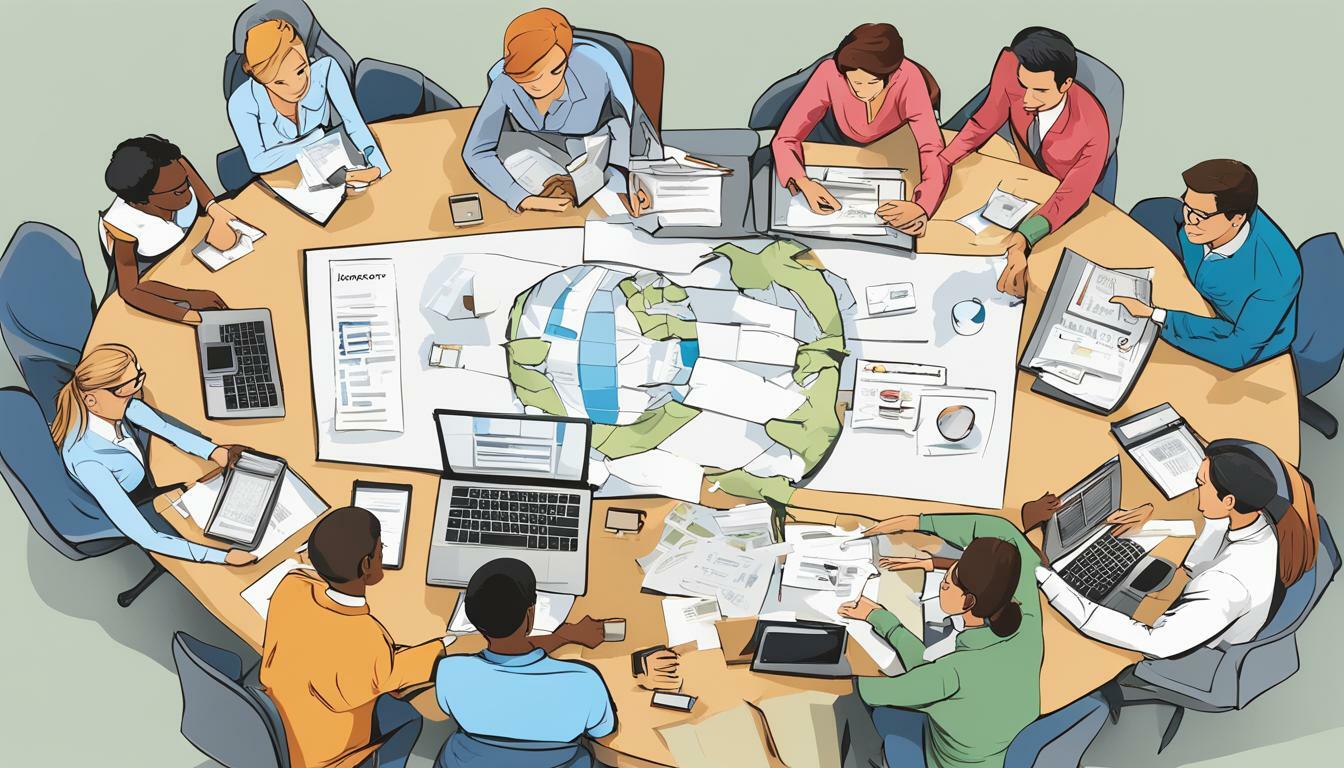
Managing a software development team can be a challenging task. With multiple team members working on different aspects of the project, it’s important to ensure everyone has clearly defined roles and responsibilities to achieve the project’s goals. Understanding the dynamics of a development team is crucial for effective management. In this article, we will demystify the various roles within a software development team and provide strategies for successful team management.
Key Takeaways
- Clear roles and responsibilities are essential for project success
- Effective communication and collaboration are crucial for team dynamics
- Software development team roles include project manager, software engineer, quality assurance analyst, and user experience designer
Understanding Software Development Team Dynamics
Software development is a complex process that involves multiple team members working together towards a common goal. Understanding software development team dynamics is key to ensuring that the project is completed successfully.
Team dynamics refer to the relationships and interactions between team members, as well as the way that the team works together to achieve its objectives. In a software development team, effective communication, collaboration, and trust among team members are crucial to the success of the project.
Developing a culture of open communication is essential to building trust among team members. This involves creating an environment where team members feel comfortable expressing their thoughts, ideas, and concerns. It also means encouraging feedback from team members and valuing their contributions to the project.
The Impact of Team Dynamics on Project Success
Poor team dynamics can have a significant negative impact on project success. When team members do not communicate effectively or do not trust each other, it can lead to misunderstandings, conflicts, and delayed or incomplete work.
On the other hand, when team dynamics are strong, it can lead to improved productivity, higher quality work, and a more enjoyable work environment for all team members.
In conclusion, understanding software development team dynamics is crucial to project success. By fostering effective communication, collaboration, and trust among team members, software development teams can produce high-quality work and achieve their goals together.
Key Roles in a Software Development Team
Successful software development requires a team with diverse skill sets and expertise. Each role within the team has specific responsibilities that contribute to the overall success of the project. Here are the key roles you can expect to find in a software development team:
| Role | Responsibilities | Skills Required |
|---|---|---|
| Project Manager | Planning and coordination of project activities, risk management, resource allocation, communication with stakeholders. | Project management, leadership, communication, decision-making, problem-solving. |
| Software Engineer | Coding, testing, debugging, and maintaining software. | Programming languages, problem-solving, analytical skills, attention to detail, collaboration. |
| Quality Assurance Analyst | Testing software, identifying and documenting defects and issues, ensuring final product quality and reliability. | Testing methodologies, attention to detail, analytical skills, communication, collaboration. |
| User Experience Designer | Creating and designing intuitive, user-friendly interfaces, conducting user research, ensuring usability and accessibility. | User-centered design, prototyping, research, analytical skills, collaboration. |
It is important for each team member to have a solid understanding of their individual role and how it fits into the larger team dynamic. Clear communication and collaboration among team members are crucial in ensuring project success.
Project Roles and Responsibilities
Managing a successful software development project requires a well-coordinated team effort. While each team member plays a critical role, a project manager is ultimately responsible for ensuring everyone is working together towards the same goal.
Project Manager
The project manager is responsible for overseeing the entire software development project. They must have excellent organizational and communication skills, and be able to manage timelines, budgets, and risks. The project manager is also responsible for ensuring that the client’s requirements are being met, and that the team is delivering high-quality work on time.
Software Engineer
The software engineer is responsible for the technical aspects of the project, including coding, testing, and debugging software. They must possess strong problem-solving skills and have expertise in programming languages and development tools. They work closely with other team members to ensure that the software being developed meets the project requirements.
| Responsibilities | Skills |
|---|---|
| Coding, testing, and debugging software | Expertise in programming languages and development tools |
| Collaborating with other team members to meet project requirements | Problem-solving skills |
Quality Assurance Analyst
The quality assurance analyst is responsible for ensuring the quality and reliability of the final software product. They are responsible for creating testing plans and executing them to identify and document software defects. They work closely with the software engineer to ensure that all issues are addressed before the final product is delivered to the client.
| Responsibilities | Skills |
|---|---|
| Creating test plans and executing them | Knowledge of testing methodologies and tools |
| Identifying and documenting software defects | Attention to detail |
User Experience Designer
The user experience designer is responsible for creating intuitive and user-friendly interfaces for software applications. They conduct user research to gain insights into user behavior and preferences, and incorporate usability principles into the design process. They work closely with the project manager and software engineer to ensure that the software meets the client’s requirements as well as the needs of the end-users.
| Responsibilities | Skills |
|---|---|
| Conducting user research to inform design decisions | Knowledge of usability principles and design software |
| Creating intuitive and user-friendly interfaces | Strong communication and collaboration skills |
Effective coordination and collaboration among project team members is key to the successful delivery of a software development project. By clearly defining roles and responsibilities, and ensuring that everyone on the team understands their role in the project, a project manager can maximize the team’s productivity and ensure the software is delivered on time and within budget.
Role of Software Engineers in the Team
Software engineers play a critical role in the success of software development projects. They are responsible for the coding, testing, and debugging of software to ensure it meets the project’s requirements and specifications.
Software engineers must also work closely with other team members, such as project managers, quality assurance analysts, and user experience designers, to coordinate efforts and maintain project timelines.
Effective communication and collaboration skills are vital for software engineers, as they often work on complex projects with tight deadlines and changing requirements. They must be able to adapt quickly and work well under pressure.
Additionally, software engineers must stay up-to-date with the latest technological advancements and programming languages to ensure they are using the best tools and techniques for the project at hand.
The Importance of Quality Assurance Analysts
Quality assurance analysts play a crucial role in ensuring the reliability and quality of the final software product. They are responsible for testing software applications, identifying defects, and verifying that all requirements have been met.
One of the primary responsibilities of quality assurance analysts is to create test plans that outline the testing approach and identify the different levels of testing that will be performed. This includes functional testing to ensure that the software is working as intended, user acceptance testing to ensure that the software meets user requirements, and performance testing to ensure that the software can handle expected load and usage.
Quality assurance analysts also track and document all defects found during testing, including detailed descriptions of the steps to recreate the issue. They work closely with software engineers to reproduce and address defects and ensure that all issues are resolved before the software is released.
Additionally, quality assurance analysts play a key role in ensuring that software development processes are followed and that all quality standards are met. They work closely with other team members to identify areas for improvement and implement changes to streamline processes and improve quality.
Overall, the work of quality assurance analysts is critical to the success of a software development project. Their attention to detail and commitment to quality help ensure that the final product meets the needs of users and performs as expected.
User Experience Designers and the Team
User experience (UX) designers play a critical role in software development teams, responsible for creating user-friendly interfaces that enhance user satisfaction and engagement. Their responsibilities also include conducting thorough user research to identify user needs, preferences, and pain points.
The UX design process involves prototyping, testing, and iterating design solutions to improve user experience. UX designers collaborate with other team members, including software engineers, project managers, and quality assurance analysts, to ensure that the product meets the desired objectives.
Effective communication and collaboration with other team members are essential for UX designers. They must work closely with software engineers to ensure that the design implementation aligns with the technical requirements while also collaborating with project managers to ensure that the design meets the project scope and stays within the project timeline.
The UX designer’s responsibilities include more than just creating user interfaces. They also play a vital role in ensuring the product’s overall usability, accessibility, and quality. For this reason, they should be involved in all stages of the software development lifecycle, from ideation to launch.
Effective Software Team Management
Managing a software development team can be challenging, but implementing effective software team management strategies can help foster collaboration, boost productivity, and promote team harmony. Here are a few tips for managing your software development team:
Set Clear Goals and Expectations
It’s important to ensure that everyone on your team understands the goals of the project and what is expected of them. Clearly define project milestones and deliverables, and communicate them to the team. This will help ensure that everyone is working towards the same objectives.
Promote Collaboration and Communication
Collaboration and communication are key to successful software team management. Encourage your team members to share ideas and feedback, and foster an environment of open communication. Utilize collaboration tools to help facilitate teamwork, such as project management software or file-sharing platforms.
Resolve Conflicts Quickly
Conflicts within a software development team can create tension and negatively impact productivity. As a project manager, it’s important to address conflicts quickly and impartially. Encourage team members to resolve conflicts through open communication and collaboration, and provide support when necessary.
Provide Regular Feedback
Regular feedback is essential for software team management. Provide feedback on both individual and team performance, and be sure to offer constructive criticism when necessary. This will help team members grow and improve, and keep everyone on track to meet project goals.
Recognize Individual Strengths
While it’s important to foster collaboration and teamwork, it’s also important to recognize individual strengths. As a project manager, identify and utilize the unique skills and strengths of each team member. This will help promote a sense of ownership and investment in the project.
Embrace Change
Change is inevitable in software development, and it’s important to be adaptable. Be open to new ideas, technologies, and processes, and encourage your team members to do the same. This will help ensure that your team stays ahead of the curve and produces high-quality work.
Navigating Team Challenges
Managing a software development team is not without its challenges. Communication breakdowns, conflicting priorities, and resource constraints can often impede progress and negatively impact team dynamics. However, understanding these challenges and having strategies in place for navigating them can help maintain team productivity.
One of the most common challenges is communication breakdowns. It is essential to establish clear lines of communication within the team and ensure everyone is on the same page. Regular team meetings can help to address potential issues before they become bigger problems.
Another challenge is conflicting priorities. Different team members may have competing goals and objectives, which can lead to tension and lack of collaboration. To navigate this challenge, it is important to encourage open communication and actively seek to understand each team member’s priorities.
Resource constraints can also be a significant challenge. Limited time, budget, or personnel can lead to difficulties in meeting project goals. To navigate this challenge, it is crucial to prioritize tasks and focus on the most critical goals. Additionally, considering alternative solutions or outsourcing certain tasks can help to alleviate resource constraints.
Ultimately, navigating team challenges requires a combination of effective communication, strong leadership, and a willingness to adapt and overcome obstacles. By prioritizing team dynamics and proactively addressing potential issues, software development teams can successfully navigate challenges and achieve project success.
The Role of Project Management Tools
Effective software team management relies on having the right tools to support collaboration and productivity. Project management tools play a crucial role in ensuring that team members can work together seamlessly and efficiently.
These tools provide a centralized platform where team members can track tasks, share updates and feedback, and collaborate on documents and files. They also enable managers to monitor progress, identify potential roadblocks, and allocate resources effectively.
There is a wide range of project management tools available, each with its own set of features and benefits. It’s important to carefully evaluate these tools and select the ones that best meet your team’s needs.
Top Project Management Tools for Software Teams
Here are some of the most popular project management tools used by software teams:
| Tool | Features |
|---|---|
| Jira | Agile project management, issue tracking, custom workflows, reporting and analytics |
| Trello | Kanban boards, task management, collaboration features, integrations |
| Asana | Task management, collaboration features, custom workflows, reporting and analytics |
| Basecamp | Project management, task tracking, collaboration features, messaging, file sharing, scheduling |
| GitHub | Version control, code review, issue tracking, project management features, integrations |
Choosing the right project management tool for your team depends on various factors, including project size, team size, workflow, and budget. It’s important to take the time to research and compare different tools before making a decision.
Ultimately, using the right project management tools can help your software development team stay organized, productive, and focused on delivering high-quality software products.
Balancing Individual and Team Needs
A successful software development team consists of individuals with unique skills and strengths. Therefore, it is essential to balance individual and team needs to create a collaborative working environment that maximizes productivity and project success.
One way to achieve this balance is by recognizing and nurturing each team member’s strengths. By acknowledging and utilizing individual talents, team members feel valued and empowered, leading to increased motivation and job satisfaction.
However, while it is essential to recognize individual strengths, it is equally important to foster a sense of teamwork. This can be achieved by encouraging open communication and collaboration, setting clear team goals, and promoting shared ownership of project success.
Effective project roles and responsibilities management can also contribute to balancing individual and team needs. By clearly defining roles and expectations, team members can better understand their contributions to the project and feel confident in their responsibilities. Additionally, providing regular feedback and recognition to individuals and the team can help foster a positive and supportive working environment.
Ultimately, achieving a balance between individual and team needs requires awareness, communication, and flexibility. By nurturing individual strengths while promoting teamwork and collaboration, software development teams can thrive and achieve project success.
Conclusion
In conclusion, understanding the roles and responsibilities within a software development team is crucial for project success. Effective communication, collaboration, and trust are essential for team dynamics. The project manager, software engineer, quality assurance analyst, and user experience designer are key roles within a development team, each with its specific responsibilities and skills.
Balancing individual and team needs is essential to foster a healthy work environment. Regular communication and feedback are essential to address challenges, such as communication breakdowns and conflicting priorities. Project management tools can help track tasks, collaborate effectively, and document progress.
Remember, project success begins with a clear understanding of project roles. By clarifying responsibilities, nurturing individual strengths, and fostering a collaborative team environment, project teams can deliver quality software within budget and on time. Apply this knowledge to your team dynamics for optimal project success.
FAQ
Q: What is the importance of understanding software development team dynamics?
A: Understanding team dynamics is crucial for effective communication, collaboration, and trust among team members. It impacts the overall success of a project.
Q: What are the key roles in a software development team?
A: The key roles in a software development team include project manager, software engineer, quality assurance analyst, and user experience designer.
Q: What are the responsibilities of a project manager in a software development team?
A: Project managers are responsible for planning, coordination, and risk management. They play a vital role in project success.
Q: What do software engineers contribute to the development team?
A: Software engineers are responsible for coding, testing, and debugging software. They play a crucial role in the overall development process.
Q: What is the role of quality assurance analysts in a software development team?
A: Quality assurance analysts are responsible for testing software, identifying defects, and ensuring the quality and reliability of the final product.
Q: What is the role of user experience designers in a software development team?
A: User experience designers create intuitive and user-friendly interfaces, conduct user research, and incorporate usability principles into the design process.
Q: How can effective software team management be achieved?
A: Effective software team management can be achieved through fostering collaboration, setting clear goals and expectations, and resolving conflicts within the team.
Q: What are common challenges faced in managing a software development team?
A: Common challenges include communication breakdowns, conflicting priorities, and resource constraints. Strategies for navigating these challenges and maintaining team productivity are important.
Q: What is the role of project management tools in supporting software development teams?
A: Project management tools support teams by providing task tracking, collaboration, and documentation capabilities. Selecting and implementing the right tools is essential.
Q: How can individual and team needs be balanced within a software development team?
A: Balancing individual and team needs involves recognizing and nurturing individual strengths while fostering a collaborative team environment.








